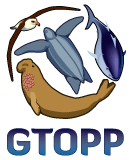Saturday, July 31, 2010
The anticipation in Kona is palpable...
We arrived at the Kona Airport around 8:00 p.m. and were greeted by the following sign at baggage claim:"Aloha" from the HIBT to travelers arriving at the Kona Airport.
Friday, July 30, 2010
The Great Marlin Race is About to Begin!!!
After a year of anticipation, Dr. Randy Kochevar and I have returned to Kona, Hawaii to help lead the 2nd Annual Great Marlin Race at the 51st Annual Hawaiian International billfish Tournament (HIBT).
Our mission is to work with HIBT anglers and crews to deploy up to fifteen satellite tags during the next week --- it will be busy week! On average, over the course of the year, Kona recreational boats report a catch rate of approximate one fish per three days of fishing. We expect better odds, however, as the months of June, July, and August are prime time for blue marlin off Kona.
Thursday, July 15, 2010
I can't believe it's just a few weeks away!
Can it possibly be that a year has already passed since we were last in Kona? But what an amazing year it has been! At the risk of repeating myself, the results from last year's race were truly amazing - and it was really exciting to see the data coming in as those final tags started transmitting!
In the time since then, our data management team has finished working on a whole new system for analyzing the data that come off these tags. Using some really sophisticated mathematics, we can now create much more realistic tracks than we could before - and because we now know the statistical error associated with each point along the track, we can also do new kinds of analyses that combine tracks from different types of tags -- which is key to carrying out ecosystem-level studies like we are currently doing in the Pacific.
This new system is a key part of a new Global Tagging of Pelagic Predators (GTOPP) program, which we've been developing for the past year. Our idea is to open our data system to collaborators all around the planet so we can all share our findings and combine and analyze them in new and different ways -- allowing us to ask and answer questions at a much larger scale than would ever be possible by a single lab working independently.
One of our first proofs of the GTOPP concept happened just a few weeks ago when the renown ocean explorer Dr. Sylvia Earle joined forces with Dr. Eric Hoffmayer from the University of Southern Mississippi to deploy electronic tags on whale sharks in the Gulf of Mexico. The data from the tags is streaming through the system we developed, and you can follow the sharks from day to day on the new GTOPP website.
In the next couple of weeks we'll be programming all the tags and putting together the rest of the gear so we're ready to hit the ground running in August. Both Dr. George Shillinger and me will be back this year, and we're looking forward to seeing everyone at the HIBT!
In the time since then, our data management team has finished working on a whole new system for analyzing the data that come off these tags. Using some really sophisticated mathematics, we can now create much more realistic tracks than we could before - and because we now know the statistical error associated with each point along the track, we can also do new kinds of analyses that combine tracks from different types of tags -- which is key to carrying out ecosystem-level studies like we are currently doing in the Pacific.
This new system is a key part of a new Global Tagging of Pelagic Predators (GTOPP) program, which we've been developing for the past year. Our idea is to open our data system to collaborators all around the planet so we can all share our findings and combine and analyze them in new and different ways -- allowing us to ask and answer questions at a much larger scale than would ever be possible by a single lab working independently.
One of our first proofs of the GTOPP concept happened just a few weeks ago when the renown ocean explorer Dr. Sylvia Earle joined forces with Dr. Eric Hoffmayer from the University of Southern Mississippi to deploy electronic tags on whale sharks in the Gulf of Mexico. The data from the tags is streaming through the system we developed, and you can follow the sharks from day to day on the new GTOPP website.
In the next couple of weeks we'll be programming all the tags and putting together the rest of the gear so we're ready to hit the ground running in August. Both Dr. George Shillinger and me will be back this year, and we're looking forward to seeing everyone at the HIBT!
Subscribe to:
Posts (Atom)





